How to run macOS on Windows 10 using VMware Workstation Player
And, just like with VirtualBox, VMware also requires patching before the macOS Monterey virtual machine will work. This guide applies to Intel and AMD systems. AMD users must use the second code snippet when editing the virtual machine's VMX file.
Files needed to create a macOS virtual machine on Windows 10 using VMware Workstation Player
Before getting into how to do it, you need to download and install the necessary tools.
You also need a copy of macOS. Monterey is the latest stable version of macOS at the time of writing, although macOS Ventura is coming soon, You can find download links for macOS Monterey in the link below.
Signing in to your iCloud account on a VMware Player virtual machine is much easier than on a VirtualBox virtual machine. Even though this is a working version of macOS on Windows, not all features included in macOS will work.
When the download is complete, right-click the file and select "Extract to macOS Monterey" using an extraction tool such as WinZip or 7-Zip.
How to run macOS on Windows 10 using VMware Workstation Player
1. VMware Workstation Player patch

Before you start adding, download the latest version of the patch tool.
Step 1: Browse to the location where you downloaded the patch tool. Extract the contents of the archive. This process works best when the folders are on the same drive (for example, both the VMware root folder and the extracted archive are found on the C: drive).
Step 2: Make sure VMware is completely closed. In the Unlocker folder, right-click on the win-install command file and select Run as Administrator . The Command Prompt window opens and the patch script will run.
Please note. As the script runs, you need to watch for any "File not Found" messages .
The most common reason for the "file not found" or "system cannot find the file specified" message is installing VMware Workstation Player in a different location than the default folder and executing the patch from a different folder.
Once the patch is complete, you can open VMware.
2. Create a macOS Monterey virtual machine with VMware

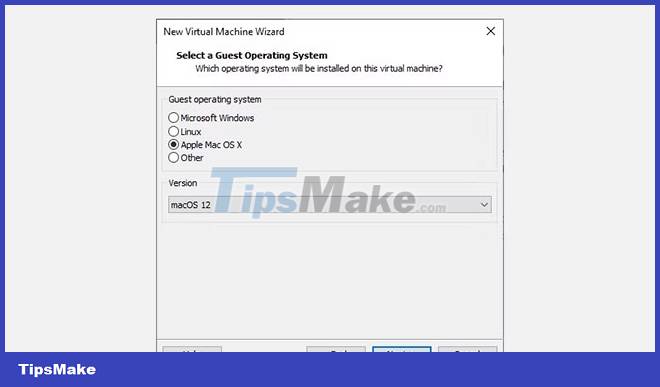


Step 1: Select Create a New Virtual Machine . Select I will install the operating system later .
Step 2: Now , select Apple Mac OS
Step 3: Next, you need to choose a name for your macOS Monterey virtual machine. Choose something easy to remember, then copy the file path somewhere handy - you'll need it to make some edits in a moment.
Step 4: On the next screen, set the drive size to 50GB or larger and select Store virtual disk as a single file . Complete the virtual drive creation wizard, but do not start the virtual machine yet.
3. Edit macOS Monterey virtual machine settings
Before you can start the virtual machine, you must edit the hardware parameters.
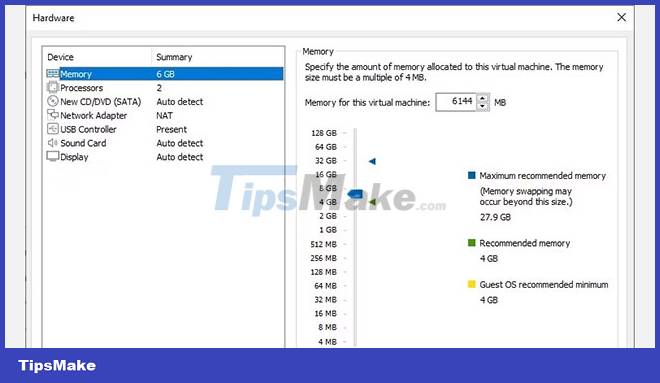
Step 1: From the VMware home screen, select your macOS Monterey virtual machine, then right-click and select Settings.
Step 2: Increase virtual machine memory to at least 4GB. You can allocate more if you have RAM to spare.
Step 3: In Processors , edit the number of available cores to 2 (or more if available).
Step 4: Now, select New CD/DVD (SATA) > Use ISO image file . Browse to the macOS Monterey ISO file and select it.
Step 5: Close the Hardware window and select Finish.
However, don't start the VMware Workstation Player macOS Monterey virtual machine right away. There are still some tweaks to make to the configuration files.
4. Edit macOS Monterey VMX file for Intel hardware
This section is for Intel users. It involves the last set of tweaks you need to make before turning on your VMware macOS Monterey virtual machine!
Close VMware. Go to the location where you stored your macOS virtual machine. The default location is:
C:UsersYOURNAMEDocumentsVirtual MachinesYOUR MAC OS X FOLDERBrowse to macOS Monterey.vmx, right-click, and select Open with > Notepad (or your preferred text editor). Scroll to the bottom of the configuration file and add the following line:
smbios.reflectHost = "TRUE" hw.model = "MacBookPro14,3" board-id = "Mac-551B86E5744E2388" smc.version = "0"
Select Save > Exit .
Now you can open VMware, select your macOS Monterey virtual machine, and fire it up!
5. Edit macOS Monterey VMX file for AMD hardware
This section is for AMD users. Like the above section, AMD users must also edit the VMX file before continuing. The AMD version includes more lines than the Intel version, but you can copy and paste data into the file.
Close VMware. Go to the location where you stored your macOS virtual machine. The default location is:
C:UsersYOURNAMEDocumentsVirtual MachinesYOUR MAC OS X FOLDERBrowse to macOS Monterey.vmx, right-click, and select Open with > Notepad (or your preferred text editor). Scroll to the bottom of the configuration file and add the following lines:
cpuid.0.eax = '0000:0000:0000:0000:0000:0000:0000:1011' cpuid.0.ebx = '0111:0101:0110:1110:0110:0101:0100:0111' cpuid.0.ecx = '0110:1100:0110:0101:0111:0100:0110:1110' cpuid.0.edx = '0100:1001:0110:0101:0110:1110:0110:1001' cpuid.1.eax = '0000:0000:0000:0001:0000:0110:0111:0001' cpuid.1.ebx = '0000:0010:0000:0001:0000:1000:0000:0000' cpuid.1.ecx = '1000:0010:1001:1000:0010:0010:0000:0011' cpuid.1.edx = '0000:0111:1000:1011:1111:1011:1111:1111'Select Save > Exit .
Now you can open VMware, select your macOS Monterey virtual machine, and fire it up!
6. Configure and install the macOS Monterey virtual machine
After launching the macOS Monterey virtual machine, you will have to configure the storage drive before installation.
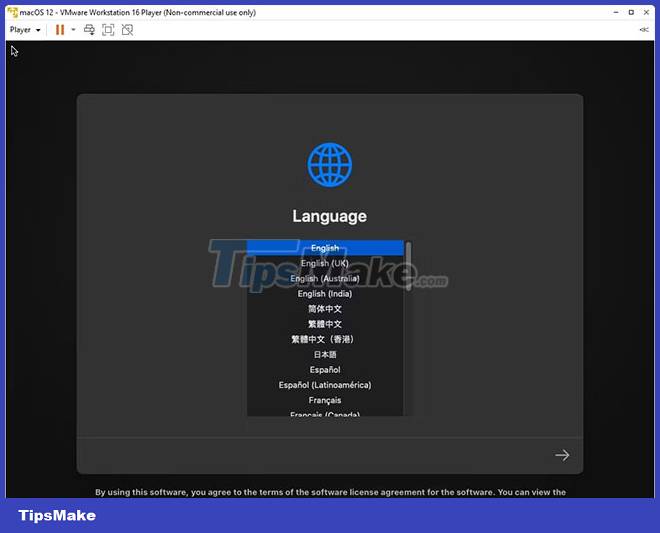


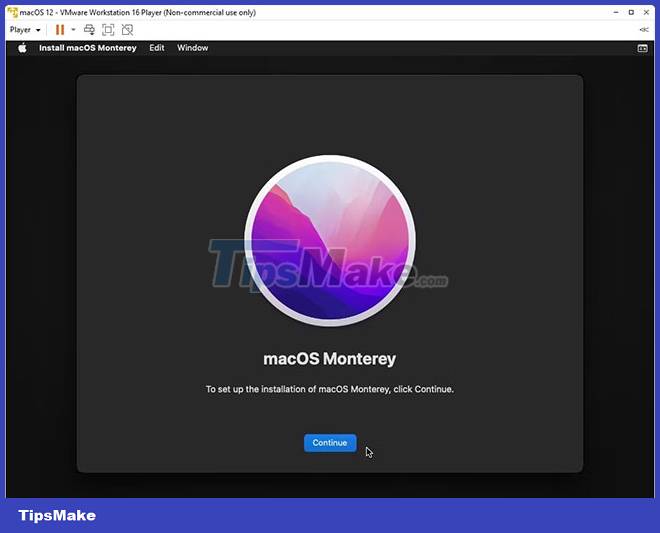
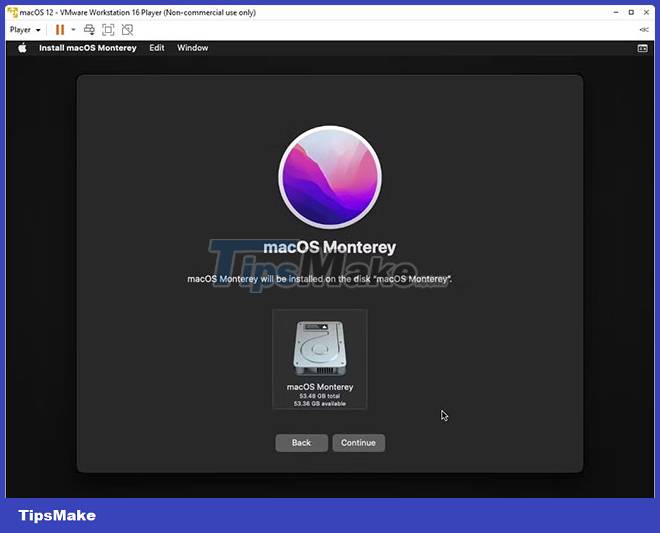
Step 1: Next, select Disk Utility. You create a clean drive for macOS Monterey to install.
Step 2: In Disk Utility , select VMware Virtual SATA Hard Drive Media from the Internal drive column.
Step 3: After selecting the drive, go to the Erase option found at the top of the utility.
Step 4: Name the drive, set Format to APFS and Scheme to GUID Partition Map .
Step 5: Select Erase.
Step 6: Once completed, you can exit Disk Utility to return to the Monterey recovery screen. From here, you need to select Install macOS Monterey .
Step 7: Select the drive you created in Disk Utility > Continue .
Installation takes a while but is faster than VirtualBox. Once macOS Monterey loads, you can configure the operating system as you see fit.
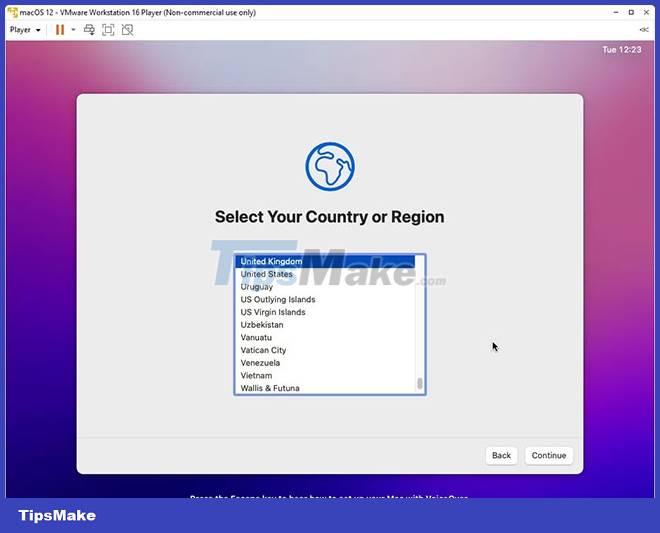

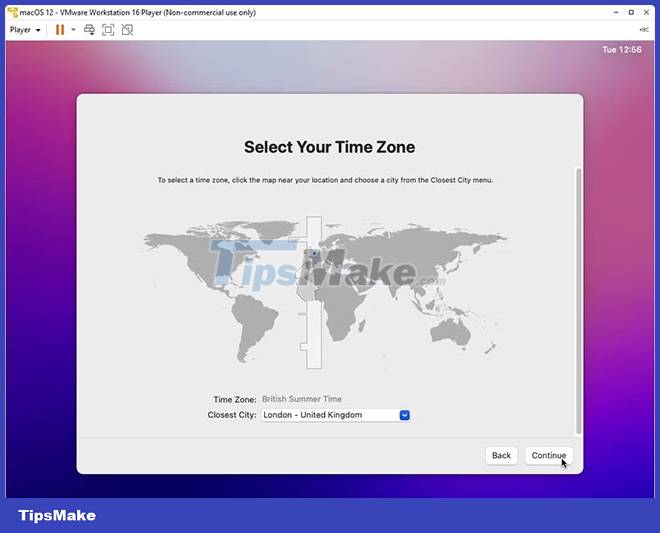
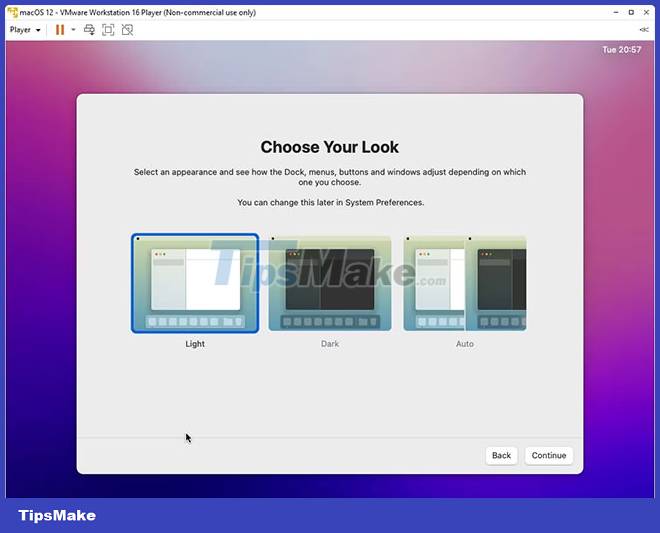
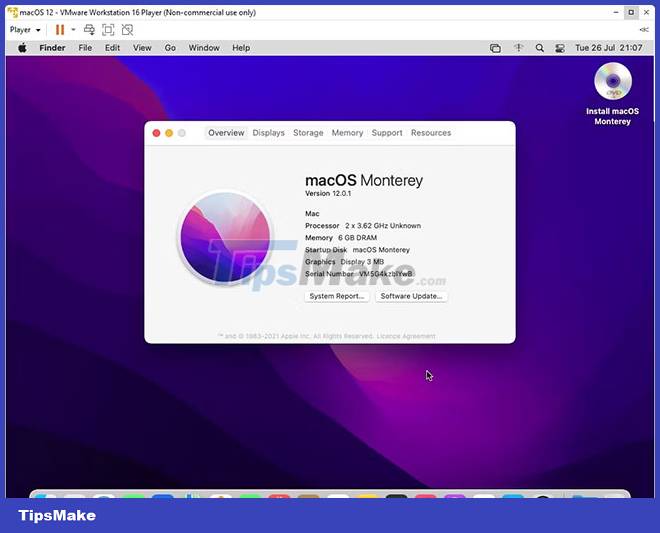
7. Install VMware Tools into the macOS Monterey virtual machine
Now, you need to install VMware Tools, which is a collection of utilities and extensions that improve mouse handling, video performance, and other useful things.
With the macOS virtual machine running, go to Player > Manage > Install VMware Tools .
The installation disc will appear on the macOS desktop. When the option appears, select Install VMware Tools , then allow it to access the removable volume. Follow the guided installer, which will require a reboot after completion.
Resovle problem
A few things can go wrong during the process of installing a macOS virtual machine in VMware Player Workstation.
1. If you can't see "Apple Mac OS X" in the virtual machine creation wizard, you need to review the patching process. Make sure to shut down any processes related to VMware Player.
2. If you receive the message "Mac OS X is not supported with binary translation" when starting your virtual machine, you most likely need to enable virtualization in your BIOS/UEFI configuration.
3. If you receive the message "VMware Player unrecoverable error: (vcpu-0)" when starting the virtual machine, you need to go back to the macOS Monterey.vmx configuration file to make sure you added the additional line and save the copy edit.
4. If you are running AMD hardware and stuck at the Apple logo, power down the virtual machine first. Now, go to Settings > Options > General . Change Guest operating system to Microsoft Windows and Version to Windows 10 x64 . Click OK , then try turning on the virtual machine again. Once the Apple logo passes, power off the virtual machine, then set the Guest operating system option back to Apple Mac OS X , selecting the correct version.
You should read it
- How to fix mouse error and virtual machine keyboard in VirtualBox
- VirtualBox and VMware: Which virtual machine software is better?
- Fix the error of not running VMware virtual machine, VirtualBox on Windows 10
- How to install macOS in VirtualBox
- How to install macOS Mojave on Windows 10
- Stealing virtual machines and virtual machine data
- Learn about virtual machines
- How to set up a Windows virtual machine in Linux
May be interested
- Instructions for fixing errors do not install VMware Tools
 you have successfully installed the virtual machine, but you cannot perform the drag and drop operation between the real machine and the virtual machine as before, you cannot fullscreen the virtual machine ... why? it's really simple, the reason is that vmware workstation uses the file system autoinst.flp (located in the virtual machine installation directory) to create the floppy drive ...
you have successfully installed the virtual machine, but you cannot perform the drag and drop operation between the real machine and the virtual machine as before, you cannot fullscreen the virtual machine ... why? it's really simple, the reason is that vmware workstation uses the file system autoinst.flp (located in the virtual machine installation directory) to create the floppy drive ... - Virtual PC 2004 or VMware Workstation 4.5?
 vmware workstation and virtual pc are two familiar virtual machine creation software but for easy selection, you need to find similarities, differences, strengths and weaknesses between them.
vmware workstation and virtual pc are two familiar virtual machine creation software but for easy selection, you need to find similarities, differences, strengths and weaknesses between them. - Run Ubuntu in Windows 7 using VMware Player
 with vmware player, you can install a complete ubuntu copy and integrate it with your windows 7 pc for free.
with vmware player, you can install a complete ubuntu copy and integrate it with your windows 7 pc for free. - Steps to create VMware Workstation virtual machine on Windows 7/8/10/11
 create virtual computers with detailed vmware software. instructions on how to install virtual computer on windows 7/8.. by ghost or install win on virtual computer...
create virtual computers with detailed vmware software. instructions on how to install virtual computer on windows 7/8.. by ghost or install win on virtual computer... - VMware Fusion Pro is available for free for personal use
 vmware desktop hypervisor fusion and workstation products are used by millions of people every day to run virtual machines on windows, linux, and mac computers.
vmware desktop hypervisor fusion and workstation products are used by millions of people every day to run virtual machines on windows, linux, and mac computers. - Instructions for installing Ubuntu on VMware Workstation - Part 2
 in the previous section of the article, we jointly established vmware and ubuntu desktop. and the next section below, please continue with the steps to install ubuntu desktop on vmware workstation.
in the previous section of the article, we jointly established vmware and ubuntu desktop. and the next section below, please continue with the steps to install ubuntu desktop on vmware workstation. - Top 5 tips for installing and using VMware virtual machine
 vmware workstation is software that allows you to create a virtual machine that runs in parallel on the physical computer. to experience the best vmware, you can use 5 vmware tips through the tutorial below.
vmware workstation is software that allows you to create a virtual machine that runs in parallel on the physical computer. to experience the best vmware, you can use 5 vmware tips through the tutorial below. - How to create a Windows 10 virtual machine with VMware Player and VirtualBox
 having a virtual machine at hand can be useful for a variety of purposes, such as testing software or edits in a sandbox environment separate from your main operating system.
having a virtual machine at hand can be useful for a variety of purposes, such as testing software or edits in a sandbox environment separate from your main operating system. - How to open VMDK files in VirtualBox and VMWare Workstation
 opening vmdk files with virtualbox and workstation is not as simple as many people think. you can't just double-click a file and expect it to load, nor can you load it directly with your hypervisor.
opening vmdk files with virtualbox and workstation is not as simple as many people think. you can't just double-click a file and expect it to load, nor can you load it directly with your hypervisor. - Instructions for installing Windows 10 in VMware Workstation virtual machine
 there are currently ways to download windows 10 iso files directly from microsoft, so how to install and test this windows 10 version in a virtual machine? are the steps similar to previous windows versions? please continue reading the lower part of the article!
there are currently ways to download windows 10 iso files directly from microsoft, so how to install and test this windows 10 version in a virtual machine? are the steps similar to previous windows versions? please continue reading the lower part of the article!










 How to Add Movies to iPad
How to Add Movies to iPad How to Lock iPad Screen Orientation
How to Lock iPad Screen Orientation How to Take a Screenshot on a Samsung Tablet
How to Take a Screenshot on a Samsung Tablet How to Check and Install Updates on Mac
How to Check and Install Updates on Mac How to Connect Macbook Air to Monitor
How to Connect Macbook Air to Monitor How to Connect Tablet to Computer
How to Connect Tablet to Computer